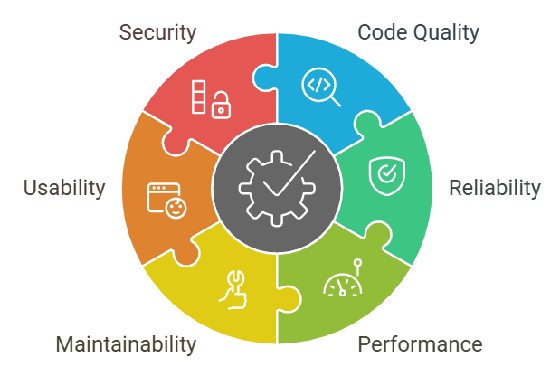High quality is one of the most important nonfunctional requirements in software development. With the aid of software quality metrics, developers can assess different aspects of the development process, such as maintainability, reliability, performance, usability, and security. These factors improve the efficiency of the software development life cycle and improve end-user satisfaction.

1. Code Quality Metrics
Code quality metrics assess the overall health of the source code. Common metrics include:
- Cyclomatic complexity: The number of independent paths through the code. Higher complexity indicates lower maintainability and increased risk of bugs.
- Code coverage: The percentage of the codebase covered by automated tests. A higher percentage generally indicates better-tested code. But, high coverage alone does not guarantee quality.
- Code churn: Measures the frequency and extent of code changes. High churn can indicate instability in the codebase.
2. Reliability Metrics
Reliability metrics evaluate the likelihood of the software running without failures. Key metrics include:
- Mean time between failures (MTBF): The average time between system failures. A higher MTBF indicates better reliability.
- Mean time to repair (MTTR): The average time required to fix a failure. A shorter MTTR suggests quicker recovery from issues.
- Failure rate: The number of failures over a defined period. A lower failure rate means the software is more stable.
3. Performance Metrics
Performance metrics measure the efficiency and responsiveness of the software. Important metrics include:
- Response time: The time the system takes to respond to a request. Lower response times indicate better performance.
- Throughput: Measures how many operations the system can handle per unit of time. Higher throughput indicates greater efficiency.
- Resource utilization: The amount of system resources (CPU, memory, disk I/O) consumed by the software. Optimal resource utilization suggests well-optimized performance.
4. Maintainability Metrics
Maintainability metrics measure how easily you can maintain or update the software.
- Technical debt: The cost of rework due to shortcuts taken in development. Lower technical debt indicates easier maintenance and better long-term sustainability.
- Code documentation: The extent to which the code is documented.
- Modularity: The percentage of independent, reusable components in the codebase. Higher modularity improves maintainability and scalability.
5. Usability Metrics
Usability metrics measure how easy it is for users to interact with the software. Key metrics include:
- User satisfaction: Typically measured through surveys, feedback, or net promoter scores (NPS). Higher satisfaction suggests better usability.
- Task success rate: The percentage of tasks users can complete successfully without assistance. A higher success rate indicates a better user experience.
- Error rate: The number of user errors encountered while using the software. A lower error rate suggests a more intuitive interface.
6. Security Metrics
Security metrics evaluate the software’s ability to resist threats and vulnerabilities. Important metrics include:
- Vulnerability density: The number of security vulnerabilities per unit of code. Lower density indicates a more secure system.
- Security incidents: The number of reported security breaches or vulnerabilities. Fewer incidents suggest a better security posture.
- Patch management: Measures how effectively security patches are applied. Faster and more consistent patching indicates strong security management.
Conclusion
Software quality metrics address the key elements of a software product, including code quality, reliability, performance, maintenance, usability, and security. These metrics allow proactive issue management, process optimization, and quality software development. With a data-driven approach toward software development, you can easily ensure the efficiency and long-term sustainability of the project.

